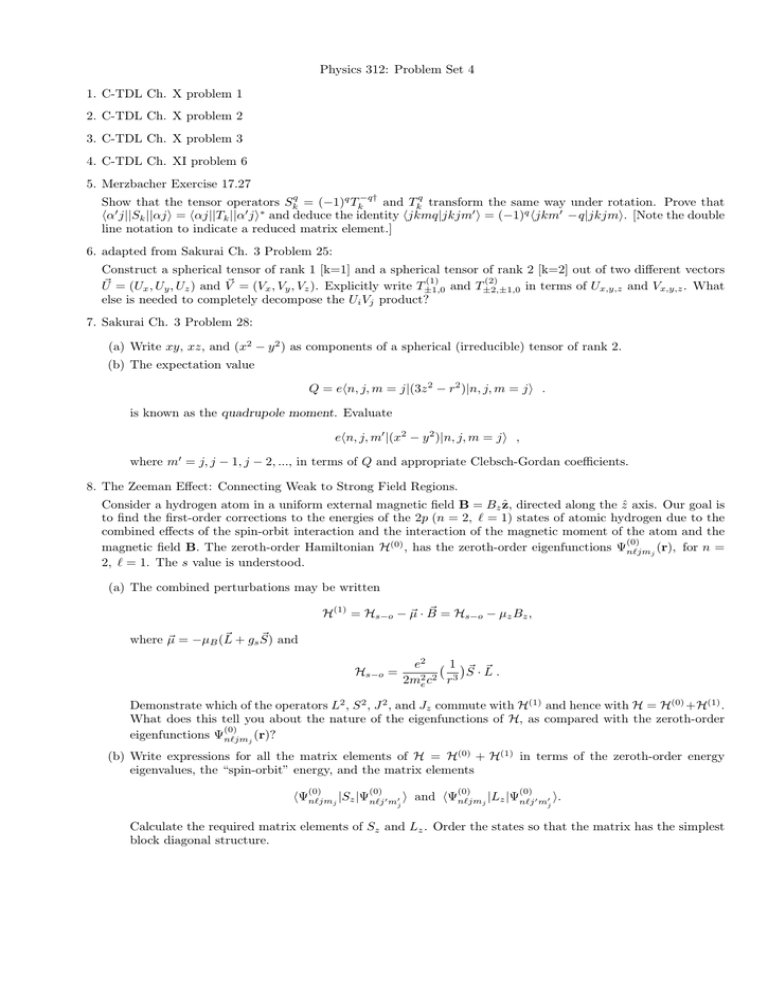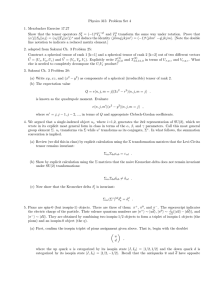Physics 312: Problem Set 4 1. C-TDL Ch. X problem 1
advertisement

Physics 312: Problem Set 4 1. C-TDL Ch. X problem 1 2. C-TDL Ch. X problem 2 3. C-TDL Ch. X problem 3 4. C-TDL Ch. XI problem 6 5. Merzbacher Exercise 17.27 Show that the tensor operators Skq = (−1)q Tk−q† and Tkq transform the same way under rotation. Prove that hα0 j||Sk ||αji = hαj||Tk ||α0 ji∗ and deduce the identity hjkmq|jkjm0 i = (−1)q hjkm0 −q|jkjmi. [Note the double line notation to indicate a reduced matrix element.] 6. adapted from Sakurai Ch. 3 Problem 25: Construct a spherical tensor of rank 1 [k=1] and a spherical tensor of rank 2 [k=2] out of two different vectors ~ = (Ux , Uy , Uz ) and V ~ = (Vx , Vy , Vz ). Explicitly write T (1) and T (2) U ±1,0 ±2,±1,0 in terms of Ux,y,z and Vx,y,z . What else is needed to completely decompose the Ui Vj product? 7. Sakurai Ch. 3 Problem 28: (a) Write xy, xz, and (x2 − y 2 ) as components of a spherical (irreducible) tensor of rank 2. (b) The expectation value Q = ehn, j, m = j|(3z 2 − r2 )|n, j, m = ji . is known as the quadrupole moment. Evaluate ehn, j, m0 |(x2 − y 2 )|n, j, m = ji , where m0 = j, j − 1, j − 2, ..., in terms of Q and appropriate Clebsch-Gordan coefficients. 8. The Zeeman Effect: Connecting Weak to Strong Field Regions. Consider a hydrogen atom in a uniform external magnetic field B = Bz ẑ, directed along the ẑ axis. Our goal is to find the first-order corrections to the energies of the 2p (n = 2, ` = 1) states of atomic hydrogen due to the combined effects of the spin-orbit interaction and the interaction of the magnetic moment of the atom and the (0) magnetic field B. The zeroth-order Hamiltonian H(0) , has the zeroth-order eigenfunctions Ψn`jmj (r), for n = 2, ` = 1. The s value is understood. (a) The combined perturbations may be written ~ = Hs−o − µz Bz , H(1) = Hs−o − µ ~ ·B ~ + gs S) ~ and where µ ~ = −µB (L Hs−o = 1 ~ ~ e2 S·L. 2m2e c2 r3 Demonstrate which of the operators L2 , S 2 , J 2 , and Jz commute with H(1) and hence with H = H(0) +H(1) . What does this tell you about the nature of the eigenfunctions of H, as compared with the zeroth-order (0) eigenfunctions Ψn`jmj (r)? (b) Write expressions for all the matrix elements of H = H(0) + H(1) in terms of the zeroth-order energy eigenvalues, the “spin-orbit” energy, and the matrix elements (0) (0) (0) (0) hΨn`jmj |Sz |Ψn`j 0 m0 i and hΨn`jmj |Lz |Ψn`j 0 m0 i. j j Calculate the required matrix elements of Sz and Lz . Order the states so that the matrix has the simplest block diagonal structure. (c) Solve for all the roots, thereby obtaining the energy eigenvalues of H correct to first order. Based on your results, draw an energy level diagram that shows how the energy levels change as the perturbations Hs−o and −µz Bz are included and the strength of the magnetic field changes. Use the fact that mj values repel to connect weak field limit values to strong field limit values. (d) Taking the weak field limit, show that your answer recaptures the results obtained in class. What results do you get in the strong field limit? 9. Pions are spin-0 (but isospin-1) objects. There are three of them: π + , π 0 , and π − . The superscript indicates the electric charge of the particle. Their valence quantum numbers are |π + i ∼ |udi, |π 0 i ∼ √12 (|uui − |ddi), and |π − i ∼ |dui. They are obtained by combining two isospin-1/2 objects to form a triplet of isospin-1 objects (the pions) and an isospin-0 object (the η). (a) First, confirm the isospin triplet of pions assignment given above. That is, begin with the doublet u , d where the up quark u is categorized by its isospin state |I, I3 i = |1/2, 1/2i and the down quark d is categorized by its isospin state |I, I3 i = |1/2, −1/2i. Recall that the antiquarks u and d have opposite electric charge and opposite I3 quantum number from their quark counterparts. Therefore, u has the isospin quantum numbers |I, I3 i = |1/2, −1/2i and d has the isospin quantum numbers |I, I3 i = |1/2, 1/2i. u The doublet transforms as a 2 under SU(2) (multiplicity=2 · (I = 1/2) + 1). u d on the other d hand, transforms like a 2 under SU(2). However, you have already shown that the Levi-Civita tensor is invariant under an SU(2) rotation, so it can be used to change the 2 objects to 2 objects: If ai (i = 1, 2) indicates the components of u d , find bj = jk ak , summation implied. So you have just found how to express the antiquarks as a 2. (The epsilon tensor behaves as a raising or lowering operator in SU(2) the way the metric tensor gµν is used to raise or lower Lorentz indices.) You know how to combine 2 ⊗ 2 from your spin work, so do that in order to write the triplet of pions, |I, I3 i = |1, 1i, |1, 0i, and |1, −1i in terms of the quark basis. How do the expressions compare to the triplet you obtain by combining two (regular) spin-1/2 objects? (b) Show that all possible electrically neutral two-pion final states have total isospin I = 0 or 2 and I3 = 0. Express these states in terms of the single pion basis.






